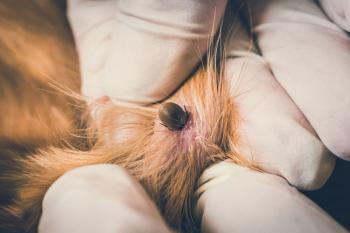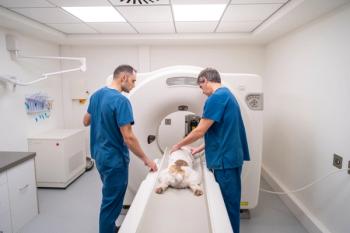
Triage in the emergency room (Proceedings)
Triage refers to a systematic evaluation of body systems, and is designed to facilitate identification of the most life-threatening problems first. In the emergency room, or even in the waiting room, patients with life-threatening abnormalities require timely intervention, and may trump other less critical patients for veterinary attention.
Triage refers to a systematic evaluation of body systems, and is designed to facilitate identification of the most life-threatening problems first. In the emergency room, or even in the waiting room, patients with life-threatening abnormalities require timely intervention, and may trump other less critical patients for veterinary attention. Initial assessment of the emergent patient should focus on evaluation of the respiratory, cardiovascular, nervous, and urogenital systems. This is the primary survey, and forms the core of a triage exam. The secondary survey evaluates the systems from the primary survey in more depth (e.g. thoracic auscultation), or may evaluate other systems (e.g. abdominal palpation), and may be performed at a more leisurely pace (as life-threatening concerns have been initially ruled out in the primary survey). The definitive etiology of disease may not be evident on presentation to the hospital, and so the use of a triage system ensures that abnormalities are identified and treated in a systematic and symptomatic manner.
A proper triage exam should take no more than 2 minutes, and in addition to the primary survey, a capsule history may be obtained from the owner. Questions such as, “why have you brought your pet to the emergency room today,” and “does he/she have any prior medical conditions” may be asked while during observation of respiratory characteristics or pulse palpation. The data from this capsule history and primary survey provides the basis for the generation of an initial problem list and plan.
Respiratory triage
Assessment should be made of both respiratory rate and respiratory effort. Animals with an increased respiratory rate (tachypnea) may be nervous or painful, or may have a primary problem affecting the respiratory or cardiovascular system. Animals that are having difficulty breathing (dyspnea) may show a characteristic posture (orthopnea, characterized by an extended neck, and a base-wide forelimb stance). Open-mouthed breathing is abnormal in the cat. If an animal has a degree of obstruction in the airway, they may generate noise while breathing; these noises may be characterized as stertor (a snoring-type noise) or stridor (a high-pitched noise commonly associated with inspiration). The assessment of an animal's respiratory pattern and noise can be done even while walking up to the patient in the waiting room, and plays an important part of triage for respiratory disease.
Airway patency should be assessed immediately in animals with dyspnea. Animals with upper airway obstruction may have exaggerated abdominal effort on inspiration or expiration, and may produce no airflow at all, or the noises described above. Animals with lower-respiratory disease (eg. feline asthma) frequently display a prolonged exhalation phase of breathing. Animals with thoracic airway obstruction (eg. tracheal collapse) will have a fast inspiration followed by a slow, deliberate exhalation. Animals with air or fluid in the pleural space will have a short, shallow inspiratory phase. Animals with pulmonary parenchymal disease may have either inspiratory or expiratory dyspnea, or both. Stress in these animals should be minimized, and often a short period of quiet in an oxygen-enriched environment (eg. oxygen cage) will make some animals more comfortable and stable for the secondary survey. If it is necessary to perform the secondary survey immediately, or if other procedures are necessary, the provision of oxygen by a facemask, or even from the hoses of an anesthesia machine is a reasonable way to provide extra oxygen to these patients. If the patient is in extremis or extremely agitated, it is sometimes necessary to induce anesthesia, secure an endotracheal tube and breathe for the animal using 100% oxygen while additional assessment occurs.
Cardiovascular triage
A thorough cardiovascular triage includes evaluation of mucous membranes, capillary refill time (CRT), pulse rate and quality, and a search for any hemorrhage that needs to be controlled. Animals with cardiovascular disease or heart failure may also have difficulty breathing and cold extremities. The cardiovascular and respiratory systems are closely linked, and it may not be immediately obvious in some patients as to which system is affected, but immediate initial therapy (ie. oxygen) is indicated in both.
The peripheral pulses (especially the femoral pulse) should be evaluated for strength, rhythm and quality. Metatarsal pulses may also be palpated, and may be difficult to find in patients with low blood pressure or systemic vasoconstriction. Irregular rhythms, brady or tachyarrhythmias, dropped beats, or poorly palpable pulses merit further investigation. At the very least, an apex beat of the heart, usually found in the left axillary region, may be palpated.
The most easily evaluated mucous membrane surface is the gums or the buccal surface of the mouth. The prepuce or vulva may also be evaluated for color as part of the mucous membrane assessment, especially if the gums are difficult to assess. Normal mucous membranes are pink, but may also be pigmented in normal dogs and cats. Abnormal colors include cyanosis, where the membranes appear blue or purple due to a lack of oxygenated hemoglobin. Cyanosis is seen in periods of extreme hypoxemia. Animals with certain types of congenital heart disease (right to left shunts) can also present with cyanosis.
Mucous membranes in animals with extremely poor blood flow may appear dark blue or purple-grey; this is described as a “muddy” appearance, and is seen in the later stages of septic shock. These muddy membranes are usually accompanied by poor peripheral pulses if the patient is in decompensated shock. Pale mucous membranes may be caused by anemia., although animals that are severely anemic will have white membranes. Animals that have anemia due to hemolysis (e.g. from immune-mediated hemolytic anemia) will frequently display jaundiced or yellow mucous membranes (also termed icteric). These animals, with anemia and normo- to hypervolemia, will display bounding pulses. These pulses are stronger than normal, and are caused by the increased cardiac output that accompanies this type of anemia. Animals with vasoconstriction will also have pale membranes. Animals presenting with white mucous membranes should be attended to immediately.
Hyperdynamic or septic shock is characterized by brick red mucous membranes, caused by vasodilation or distributive shock. These animals, in a state of compensatory shock, will also have bounding pulses due to elevated cardiac output. In addition to animals with hemolysis, those with hepatobiliary disease will display icteric membranes. Small splotchy areas of hemorrhage (petechiae) on the gums may indicate a problem with platelet function. Brown mucous membranes are classically seen in cats after ingestion of acetaminophen, and represent high circulating methemoglobin concentrations.
Capillary refill time (CRT) gives an estimate of the volume status and cardiac output. The mucous membranes are blanched with pressure from a finger, and the return of color is timed. Normal CRT should be 1.5 seconds. In patients that are hypovolemic or hypotensive, CRT will be delayed to 2.5 or 3 seconds. In patients with increased cardiac output (eg. hyperdynamic shock), the CRT is usually 0.5 to 1 second. This rapid CRT is accompanied by the bounding pulses discussed above. Dehydrated animals will have dry and tacky mucous membranes, while healthy animals should have a degree of moisture. Animals that are nauseous or vomiting may also hypersalivate, which will cause the membranes to be moist, but not necessarily a measure of the animal's hydration status. The hydration status of an animal may also be evaluated by assessing skin turgor. A small portion of skin between the shoulder blades is tented, and allowed to fall back into place. Skin of animals that are dehydrated will not fall back into place immediately, indicating interstitial dehydration.
Central Nervous System (CNS) triage
Animals with CNS disease may present with many signs, from non-specific motor activity (eg. pacing) to uncontrollable seizures (status epilepticus). Animals that are actively seizing may be hyperthermic, hypoxemic, and require immediate intervention. Triage evaluation should assess mentation (alert, obtunded, stuporous, comatose), motor function, gait, and balance, and some cranial nerves. Cranial nerve abnormalities may include unequal pupil sizes (anisocoria), lack of a menace response, drooping of the lips or prolapse of the 3rd eyelid. Animals with vestibular disease may have rolling or ataxic behavior. Animals with stiffness in the thoracic limbs with the head extended (opisthotonus) may be suffering from elevated intracranial pressure and require immediate treatment. A dull mentation may also be an indication of serious intracranial or systemic disease, and these patients should also be further evaluated immediately.
Animals with spinal cord or neuromuscular disease may present with signs ranging from weakness (paresis) to lack of motor function (paralysis). Paresis or paralysis of the nerves that supply the hind limbs may also result in urinary bladder dysfunction. These patients should be evaluated to rule out urinary retention and hypoventilation. Animals that are unable to feel deep pain in paralyzed limbs are potentially candidates for immediate surgery. If the paralysis has been caused by a traumatic event, the animal should be handled carefully because of the possibility of a vertebral fracture.
Urogenital system
The initial survey of any male cat presenting to the emergency room should include a gentle palpation of the urinary bladder, to insure that he does not have urinary obstruction. This is true also in any animal presenting with signs of straining to urinate (stranguria) or frequent small urinations (pollakiuria). Animals with urinary retention secondary to obstruction or bladder rupture may have severe metabolic derangements (hyperkalemia, acidosis, hypocalcemia) that merit immediate relief of the obstruction and further therapy. If the bladder is firm, hard, or painful on palpation, the animal should be further evaluated.
Animals with uterine prolapse or priapism (persistent erection) should also be evaluated further, as should any bitch or queen who appears to be in labor, or has passed some but not all of the puppies or kittens. Primiparous queens may have long delays between kittens, but in general, if active contractions fail to produce puppies or kittens, further evaluation is necessary.
Other triage abnormalities
Other physical exam findings noted on initial triage exam that merit a rapid secondary survey and immediate therapy include bloat (manifest by a swollen or tympanic abdomen), hyperthermia, hypothermia, evidence of trauma or hemorrhage, inability to walk, or anything that seems out of the ordinary.
The secondary survey
The secondary survey follows the initial triage, and is an opportunity to complete a full physical exam, or to further investigate the abnormalities found on primary survey. Animals with respiratory disease warrant further evaluation such as thoracic auscultation, pulse oximetry, or arterial blood gas analysis. Animals with poor pulses should have the blood pressure evaluated, while animals with irregularities in their pulse rhythm should be evaluated with an ECG. A brief thoracic or cardiac ultrasound may show the presence of pleural or pericardial fluid. Patients who appear anemic or dehydrated on primary survey can be assessed by analysis of packed cell volume (PCV) or serum total solids (TS).
Suggested further reading
Aldrich, J. Global Assessment of the Emergency Patient (2005). Vet Clin NA Small Anim. 35:281-305.
Newsletter
From exam room tips to practice management insights, get trusted veterinary news delivered straight to your inbox—subscribe to dvm360.




